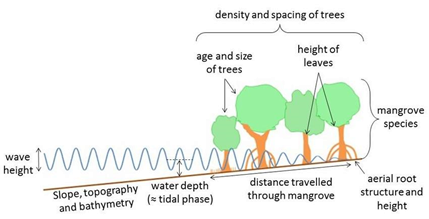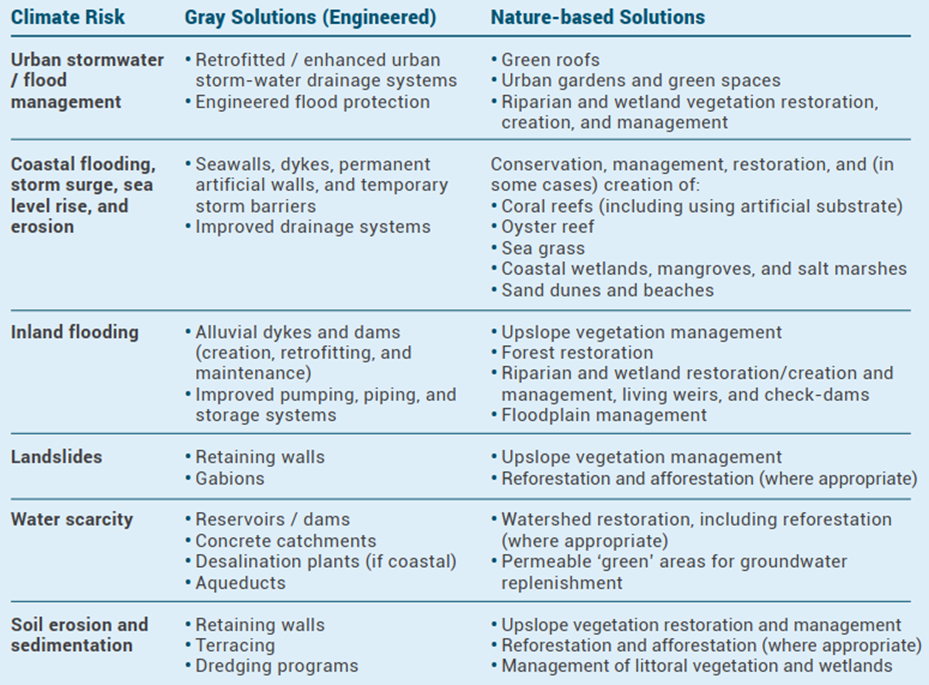
On Day 4, we will be interacting in our second virtual session on Zoom. We encourage you to complete the following readings and activities, and come to the virtual session with your reflections on Infrastructure and Nature-based Solutions.
This session will be facilitated in English with simultaneous Spanish translation. Participants can interact in the language of their choice (English or Spanish).
June 10 & 17 from 8:30AM to 11:30AM (AST)
Facilitators

Dr Paul Hinds has outstanding experience as a Regional Coordinator for the Global Water Partnership-Caribbean (GWP-C), and as a Director of Coastal Zone Management Unit for Jamaica’s Natural Resources Conservation Authority (now NEPA). He has experience in climate-resilience infrastructure management with in-depth institutional knowledge at the regional level, and engineering expertise.

Laura Nieuwenhoven has experience in various aspects of water resources management and hydrogeology, including water supply, water and sanitation. She has worked with various modeling packages including IWRM modelling using WEAP model, and has executed projects for various international NGO’s, multilateral organisations, bilateral donors, government ministries and engineering contractors.
Session’s Agenda
| Programme | June 10th or 17th, 2021 |
|---|---|
| 8:30-8:35 | Welcoming remarks and rules of engagement |
| 8:35-8:40 | Session’s objectives |
| 8:40-8:55 | Introduction to Nature-based Solutions |
| 8:55-9:05 | Engineered versus Natured-based Solutions |
| 9:05-9:25 | Coastal environment |
| 9:25-9:45 | Erosion and sediment control |
| 9:45-10:00 | Coffee break |
| 10:00-10:20 | Mitigating droughts/freshwater lens protection |
| 10:20-10:40 | Inland flooding and landslides mitigation |
| 10:40-11:00 | Wastewater treatment |
| 11:00-11:25 | Exercise |
| 11:25-11:30 | Transition to Module 5 and Closing remarks |
Introduction
This module presents nature-based solutions as alternatives to conventional grey infrastructure solutions to common climate change impacts, such as coastal erosion. Each country in the Caribbean has its own challenges, so the module seeks to showcase different solutions and case studies to serve as inspiration on the different nature-based possibilities. By using examples of existing grey engineering solutions, nature-based alternatives will be explored in peer-to-peer exchange.
Objectives
Upon completion of this module, you will be able to:
- Have a deeper understanding of what nature-based solutions are and how they differ from the grey engineering approach;
- Have insight into the benefits of nature-based solutions on different levels;
- Familiarize yourself with nature-based solutions for different climate-related challenges as well as real-life situations they have been implemented in.
To Know in this Module
- Definition of nature-based solutions
- Pros and cons of nature-based solutions compared to grey engineering
- Nature-based solutions for different climate-related challenges, from coast to upland
To-Do in this Module
| Type | Duration |
|---|---|
| Introduction to Nature-based Solutions (NbS) | 10 min |
| Example of Nature-based Solution: Mangroves and coastal wetlands | 10 min |
| Preparation: provide examples of grey infrastructure to increase climate resilience | 30 min |
Key concepts: nature-based solutions, climate resilience, coastal protection, erosion control, drought resilience, flooding mitigation, wastewater treatment.
1. Introduction to Nature-based Solutions (NbS)
Nature-based solutions (NbS) for water and sanitation is a move away from human-built, or “grey” solutions that use infrastructure to improve water management to one where “green” infrastructure focuses on preserving the functions of ecosystems, both natural and built to improve the management of water resources. These solutions work with nature, not against it, such as restoring wetlands which can protect against storms, to conserving forests that stabilize soil and runoff during floods. Mangrove forests, for example, save an estimated $80 billion per year in avoided losses from coastal flooding globally, and protect up to 18 million people.
Nature-based solutions can serve as an important component of water utilities’ adaptation to existing and future climate stressors. Historically, water utilities have mainly relied on “grey” solution (engineered) to adapt to climate stressors. There is now a shift in the appreciation and realization that NbS offers a no regrets approach in allowing water utilities to fulfil their obligations to offer sustainable, safe, and reliable drinking water. NbS have an important role to play in improving the supply and quality of water and reducing the impact of natural disasters. NbS also include using the physical environment to mitigate the impacts of climate change.
Protecting water recharge areas through afforestation and watershed management as well as coastal stabilization through wetland protection and restoration are important in water quality and quantity preservation as well as protecting structural integrity.
NbS are applicable in providing protection against climate risk in:
- i) urban stormwater/flood management;
- ii) reducing impacts from coastal flooding, storm surge, sea level rise and erosion;
- iii) inland flooding;
- iv) water scarcity;
- v) soil erosion and sedimentation.
For water utilities, the implementation of NbS can have multiple benefits. For example, managing and restoring vegetation can enable the root systems of trees and other vegetation to stabilize and restrain soils and help to reduce landslides, erosion and flood risk. Water supply is not the only benefit of NbS for utilities, as water quality is improved when watershed areas are protected by decreasing runoff, erosion and allowing natural percolation into the ground.
Along the coast, where water and sanitation facilities are often located and exposed to increasing climate stressors such as erosion, tropical cyclones, sea level rise and storm surge, NbS offer effective solutions. The table below shows some nature-based alternatives for conventional engineering solutions.
2. Example of nature-based solution: Mangroves and coastal wetlands
The restoration of wetlands, mangroves, marshes, and oyster reefs, and the installation of living shorelines (plants and natural elements designed to stabilize and protect coastlines) help reduce wave impacts during storms. Due to sea level rise, high tides are becoming higher and higher, and the highest tides—king tides, which usually occur seasonally—are projected to become daily high tides, leading to even further flooding. Fifteen feet of marsh can “absorb up to 50 percent of incoming wave energy,” and 330 feet of mangrove trees “can reduce wave height by 66 percent.” By contrast, gray infrastructure redirects, rather than dissipates, wave energy.
Marshes collect sand and sediments from the water and can grow in elevation as sea levels rise, while gray infrastructures cannot adapt and must be updated or replaced to deal with higher water levels. After Hurricane Florence (2018) hit, seawalls experienced “significant erosion and damage,” while living shorelines, such as the Beaufort living shoreline composed of oyster reef and marsh, fared much better (Environmental and Energy Study Institute, 2019).

Table 1: Engineered and Nature Based Solutions

3. Preparation
Nature-based solutions can provide alternative solutions to ‘grey infrastructure’ (conventional and hardscape design) interventions to increase climate resilience. We will explore this more during the module, for five different types of challenges, namely:
- Coastal environment (e.g. coastal erosion and sea level rise);
- Erosion and sediment control;
- Mitigating droughts and freshwater lens protection;
- Inland flooding and landslide mitigation, and;
- (Decentralised) wastewater treatment.
In module 4, we will discuss the examples during our second live session, and how Nature-based solutions could play a role to achieve the same effect as the conventional engineering had.
Exercise
Select one or two of the challenges above for which grey infrastructure interventions have been employed in your country.
Complete the exercise by clicking the link below. The exercise will open in a new tab.
